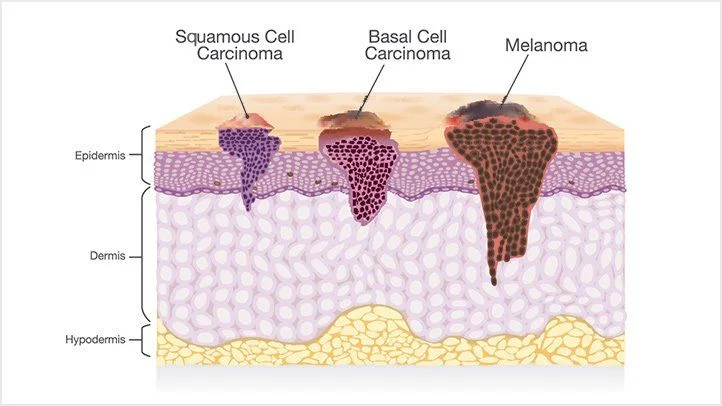Understanding the Skin Cancer
- Updated on: Nov 22, 2024
- 3 min Read
- Published on Apr 25, 2021

An Overview of Skin Cancer
Skin cancer is the most common type of all cancers and affects people with all races, color and ethnicity. Although people with light skin tone, who are more prone to sunburn, are at higher risk of getting skin cancer. It is an abnormal and uncontrolled growth of skin cells. It occurs commonly in areas exposed to sun for prolonged period such as face, hands, neck and can rarely spread to other body parts and areas having no or less exposure to sun.
Skin cancer happens due to damage of DNA by U.V radiation which can lead to mutation and genetic defect causing skin cells to grow and multiply rapidly and form malignant tumor. Skin cancer begins with the epidermis (outer skin layer) which is made up of squamous cells, basal cells, and melanocytes. Tumors are considered malignant only if they grow in uncontrolled manner becoming cancerous invading the surrounding tissues rapidly and destroying them and also through blood stream reaching to other organs and cause damage to them (metastasis).
Types of Skin Cancers:
Skin cancers are of two main types – Keratinocyte cancer (develops in skin cells called Keratinocytes) having two subtypes: Squamous cell carcinoma and Basal cell carcinoma. The other type is Melanoma cancer which occurs in skin melanocytes that generate brown pigment of the skin. Marker cell carcinoma, Skin lymphoma and Kaposi sarcoma are rare types of skin cancers.
Melanoma is a more aggressive form of skin cancer than other forms and is generally malignant in nature. If not diagnosed at an early stage, it can invade the tissues and spread to other body parts. The cases of malignant melanoma are increasing each year in the U.S. Although, it causes 2% cases of all skin cancers but causes most numbers of deaths. Early diagnosis helps in increasing survival rate from melanoma.
Squamous cell and Basal cell skin cancers are considered non-malignant and respond effectively to treatment and also rarely spread to other parts of the body. Basal cell carcinoma is the most common type of skin cancer normally develops on back, neck, face, scalp, hands, and arms. It affects nearly 2.8 million people in the U.S each year. Basal cell carcinoma occurs in parts of body exposed to sun and rarely occurs to the unexposed parts. The squamous cell carcinoma is also a commonly occurring skin cancer. It occurs on areas exposed to sun affecting around 700,000 people in the U.S. each year.

Facts and Diagnosis:
In America, more than 2 million people have been diagnosed with skin cancers each year and nearly 3.5 million cases are of Basal and Squamous cell carcinomas depicting that having diagnosed with one type of skin cancer may put a person at risk of getting other skin cancers too.
The diagnosis and detection of skin cancer type is done through two methods: first one is physical examination of the lesion or unusual skin cell growth, moles and patchy skins. Second method is skin biopsy i.e. biopsy of the skin tissues to detect cancer cells and types of cancers. Skin biopsy can be of several types for detecting both melanoma and non-melanoma skin cancer such as- Tangential (shave) biopsy, Punch biopsy, Incisional and Excisional biopsy, Optical biopsy. If chances of malignant skin cancer are noticed or detected then other biopsies are done such as- Fine Needle Aspiration biopsy, Surgical lymph Node biopsy, and Sentinel Lymph Node biopsy.
As skin cancer rates are increasing rapidly in the U.S over time, doctors suggest taking care of the skin and protecting it from harmful U.V radiations. Physicians also suggest taking proper notice of any unusual moles, scars and lesion growths on your skin and getting it diagnosed properly to check whether it is skin cancer or not. Early detection and diagnosis of the skin cancer can cure non-malignant skin cancer completely and even spreading of malignant skin cancer to different body parts. Death rates from it can be controlled to a higher extent in this way.
If you are diagnosed with skin cancer, it is important to know the type as it affects your treatment options and cancer prognosis.












